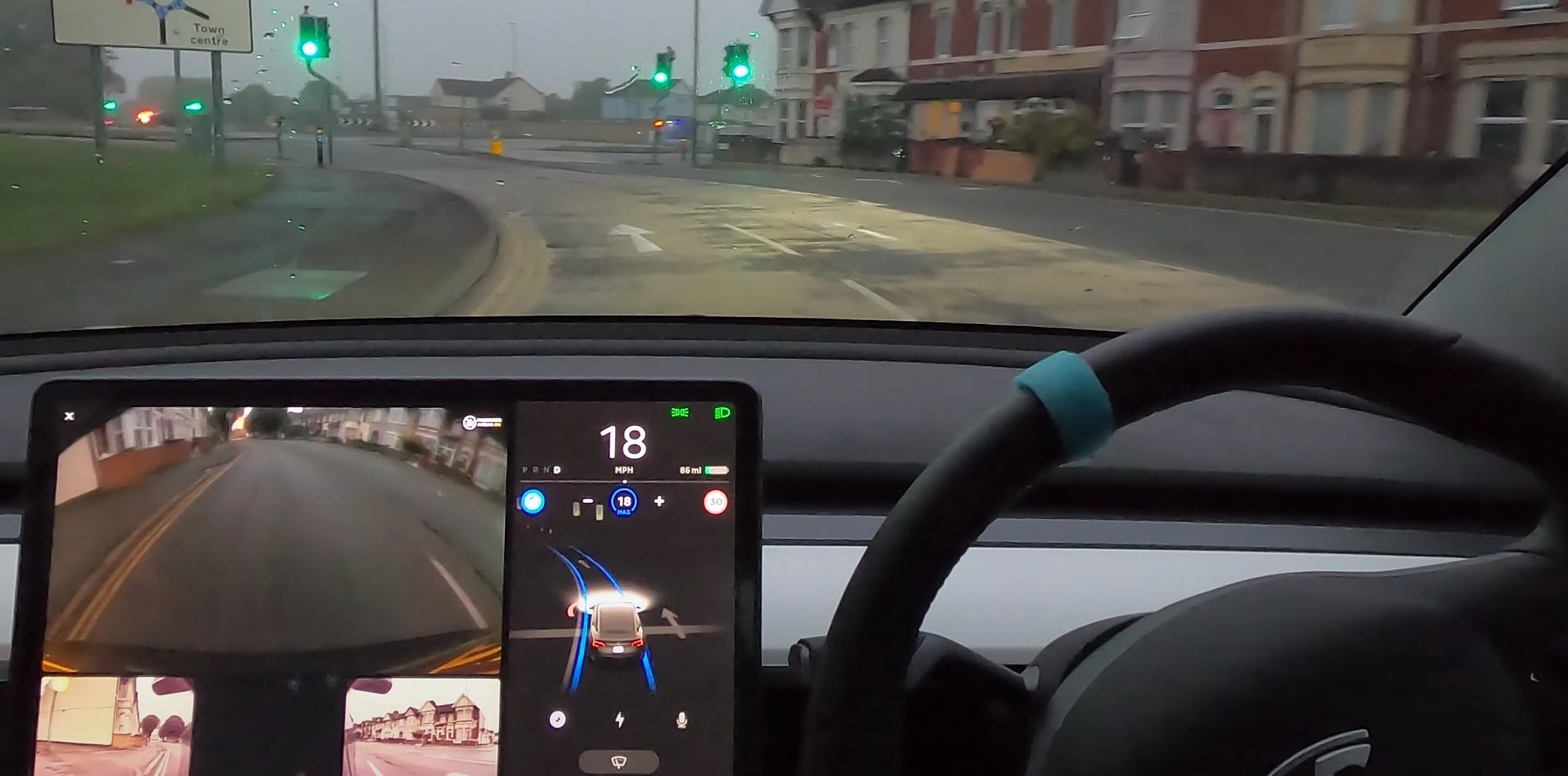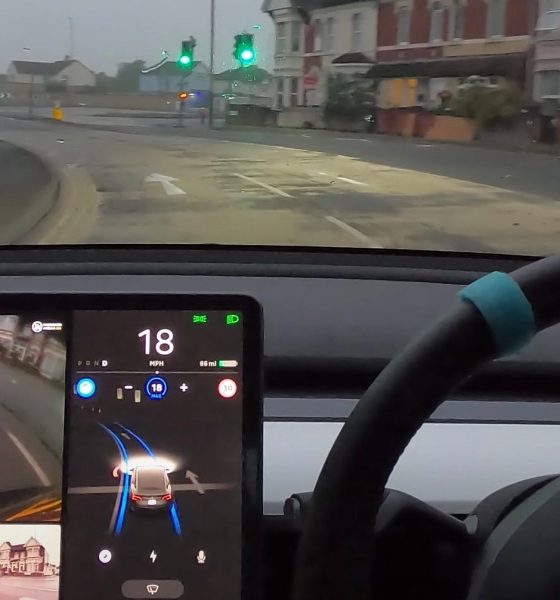

News
Tesla’s FSD Beta is navigating through roundabouts with great confidence
Ever since Tesla rolled out its Full Self-Driving Beta last week, the lucky group of individuals who have been sharing the new system’s capabilities are proving that Autopilot has improved significantly. Previously challenging tasks for the 2.5-dimension Autopilot versions are no longer a tough task thanks to a 4D comprehension of surroundings, which are a preview of what is to come with Tesla’s upcoming “Dojo” Supercomputer.
Tesla owners who have had FSD for some time know that the capabilities of the self-driving suite were somewhat limited. Everyone who purchased FSD knew it was a work in progress, and by driving with the capability activated, it was becoming more sophisticated with the help of Tesla’s Neural Network. However, the Tesla Artificial Intelligence team knew what had to be done: the amount of information that could be processed needed to be greater, and the vehicle’s comprehension of its surroundings needed to be more complex. Therefore, Tesla is developing Dojo.
Dojo is Tesla’s Neural Network training program that aims to begin breaking down data in 4D instead of “~2.5D,” which is what the automaker’s Autopilot was previously using.
Tesla’s Elon Musk details Dojo, Autopilot’s 4D training program
Musk detailed the need for a more complex autonomy system during the Q2 2020 Earnings Call:
“Well, the actual major milestone that’s happening right now is really a transition of the autonomy system or the cars, like AI, if you will, from thinking about things in — like two-and-a-half feet. It’s like think — things like isolated pictures and doing image recognition on pictures that are harshly correlated in time but not very well and transitioning to kind of a 4D, where it’s like — which is video essentially.”
The issue with previous FSD and Autopilot builds was that not enough information was being transmitted through pictures. There needed to be timestamps and more accuracy through an increasingly fluid comprehension of the surroundings. The key was to transition from images, or 2D, as Musk called it, to video, or 4D.
“So what we’ve been doing, thus far, has really just been like 2D — mostly 2D, and like I said, well correlated in time. So just hard to convey just how much better a fully 4D system would work — does work. It’s capable of things that if you just look — looking at things as individual pictures as opposed to video — basically, like you could go from like individual pictures to surround video, so it’s fundamental. So the car will seem to have just like a giant improvement.”
Roundabout Navigation
One way to show how the new system is operating more efficiently is a Tesla’s navigation of a roundabout. Musk stated that it would be able to handle roundabouts “not perfectly at first,” but it would be able to navigate through them.
Not perfectly at first, but yes. Will take maybe a year or so to get really good at roundabouts worldwide. The world has a zillion weird corner cases.
— Elon Musk (@elonmusk) August 14, 2020
Previous versions of Autopilot have had difficulties navigating through roundabouts, and very rarely did they manage to get through one without human intervention. An example can be seen in a July 2019 video from YouTuber Dirty Tesla, who showed his Model 3 attempting to go through the tricky stretch of roadway. At the 3:25 mark of the video, you can see the Model 3 doesn’t do a great job of making it through, and the driver is forced to intervene with the vehicle.
Tesla’s FSD Beta is proving that an increase in comprehension is just what Tesla Autopilot needed to function more accurately. A video from fellow Tesla Model 3 owner James Locke, who received the FSD Beta, shows the navigation through a roundabout with relative ease. Even Locke was impressed and stated that the maneuver required no intervention from him, and Autopilot took care of the entire process independently.
Dojo’s coming release in conjunction with the new FSD Beta could prove to be the answer to all of the issues that Tesla had previously. With a new, more complex system that takes in more information on terrain, surroundings, and obstacles, Autopilot is more accurate than ever before. The increase in capability is being displayed daily as new videos of the FSD Beta are being rolled out regularly.

News
Tesla aims to combat common Full Self-Driving problem with new patent
Tesla writes in the patent that its autonomous and semi-autonomous vehicles are heavily reliant on camera systems to navigate and interact with their environment.

Tesla is aiming to combat a common Full Self-Driving problem with a new patent.
One issue with Tesla’s vision-based approach is that sunlight glare can become a troublesome element of everyday travel. Full Self-Driving is certainly an amazing technology, but there are still things Tesla is aiming to figure out with its development.
Unfortunately, it is extremely difficult to get around this issue, and even humans need ways to combat it when they’re driving, as we commonly use sunglasses or sun visors to give us better visibility.
Cameras obviously do not have these ways to fight sunglare, but a new patent Tesla recently had published aims to fight this through a “glare shield.”
Tesla writes in the patent that its autonomous and semi-autonomous vehicles are heavily reliant on camera systems to navigate and interact with their environment.

The ability to see surroundings is crucial for accurate performance, and glare is one element of interference that has yet to be confronted.
Tesla described the patent, which will utilize “a textured surface composed of an array of micro-cones, or cone-shaped formations, which serve to scatter incident light in various directions, thereby reducing glare and improving camera vision.”

The patent was first spotted by Not a Tesla App.
The design of the micro-cones is the first element of the puzzle to fight the excess glare. The patent says they are “optimized in size, angle, and orientation to minimize Total Hemispherical Reflectance (THR) and reflection penalty, enhancing the camera’s ability to accurately interpret visual data.”
Additionally, there is an electromechanical system for dynamic orientation adjustment, which will allow the micro-cones to move based on the angle of external light sources.
This is not the only thing Tesla is mulling to resolve issues with sunlight glare, as it has also worked on two other ways to combat the problem. One thing the company has discussed is a direct photon count.
CEO Elon Musk said during the Q2 Earnings Call:
“We use an approach which is direct photon count. When you see a processed image, so the image that goes from the sort of photon counter — the silicon photon counter — that then goes through a digital signal processor or image signal processor, that’s normally what happens. And then the image that you see looks all washed out, because if you point the camera at the sun, the post-processing of the photon counting washes things out.”
Future Hardware iterations, like Hardware 5 and Hardware 6, could also integrate better solutions for the sunglare issue, such as neutral density filters or heated lenses, aiming to solve glare more effectively.
Elon Musk
Delaware Supreme Court reinstates Elon Musk’s 2018 Tesla CEO pay package
The unanimous decision criticized the prior total rescission as “improper and inequitable,” arguing that it left Musk uncompensated for six years of transformative leadership at Tesla.

The Delaware Supreme Court has overturned a lower court ruling, reinstating Elon Musk’s 2018 compensation package originally valued at $56 billion but now worth approximately $139 billion due to Tesla’s soaring stock price.
The unanimous decision criticized the prior total rescission as “improper and inequitable,” arguing that it left Musk uncompensated for six years of transformative leadership at Tesla. Musk quickly celebrated the outcome on X, stating that he felt “vindicated.” He also shared his gratitude to TSLA shareholders.
Delaware Supreme Court makes a decision
In a 49-page ruling Friday, the Delaware Supreme Court reversed Chancellor Kathaleen McCormick’s 2024 decision that voided the 2018 package over alleged board conflicts and inadequate shareholder disclosures. The high court acknowledged varying views on liability but agreed rescission was excessive, stating it “leaves Musk uncompensated for his time and efforts over a period of six years.”
The 2018 plan granted Musk options on about 304 million shares upon hitting aggressive milestones, all of which were achieved ahead of time. Shareholders overwhelmingly approved it initially in 2018 and ratified it once again in 2024 after the Delaware lower court struck it down. The case against Musk’s 2018 pay package was filed by plaintiff Richard Tornetta, who held just nine shares when the compensation plan was approved.
A hard-fought victory
As noted in a Reuters report, Tesla’s win avoids a potential $26 billion earnings hit from replacing the award at current prices. Tesla, now Texas-incorporated, had hedged with interim plans, including a November 2025 shareholder-approved package potentially worth $878 billion tied to Robotaxi and Optimus goals and other extremely aggressive operational milestones.
The saga surrounding Elon Musk’s 2018 pay package ultimately damaged Delaware’s corporate appeal, prompting a number of high-profile firms, such as Dropbox, Roblox, Trade Desk, and Coinbase, to follow Tesla’s exodus out of the state. What added more fuel to the issue was the fact that Tornetta’s legal team, following the lower court’s 2024 decision, demanded a fee request of more than $5.1 billion worth of TSLA stock, which was equal to an hourly rate of over $200,000.
Delaware Supreme Court Elon Musk 2018 Pay Package by Simon Alvarez
News
Tesla Cybercab tests are going on overdrive with production-ready units
Tesla is ramping its real-world tests of the Cybercab, with multiple sightings of the vehicle being reported across social media this week.

Tesla is ramping its real-world tests of the Cybercab, with multiple sightings of the autonomous two-seater being reported across social media this week. Based on videos of the vehicle that have been shared online, it appears that Cybercab tests are underway across multiple states.
Recent Cybercab sightings
Reports of Cybercab tests have ramped this week, with a vehicle that looked like a production-ready prototype being spotted at Apple’s Visitor Center in California. The vehicle in this sighting was interesting as it was equipped with a steering wheel. The vehicle also featured some changes to the design of its brake lights.
The Cybercab was also filmed testing at the Fremont factory’s test track, which also seemed to involve a vehicle that looked production-ready. This also seemed to be the case for a Cybercab that was spotted in Austin, Texas, which happened to be undergoing real-world tests. Overall, these sightings suggest that Cybercab testing is fully underway, and the vehicle is really moving towards production.
Production design all but finalized?
Recently, a near-production-ready Cybercab was showcased at Tesla’s Santana Row showroom in San Jose. The vehicle was equipped with frameless windows, dual windshield wipers, powered butterfly door struts, an extended front splitter, an updated lightbar, new wheel covers, and a license plate bracket. Interior updates include redesigned dash/door panels, refined seats with center cupholders, updated carpet, and what appeared to be improved legroom.
There seems to be a pretty good chance that the Cybercab’s design has been all but finalized, at least considering Elon Musk’s comments at the 2025 Annual Shareholder Meeting. During the event, Musk confirmed that the vehicle will enter production around April 2026, and its production targets will be quite ambitious.








